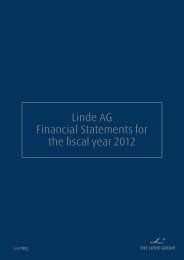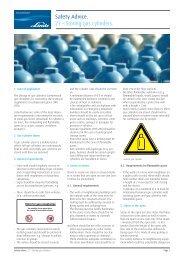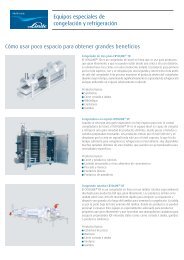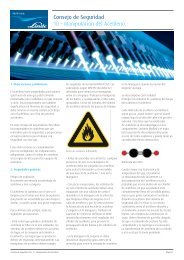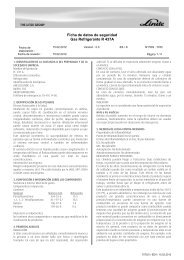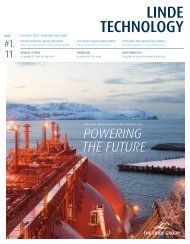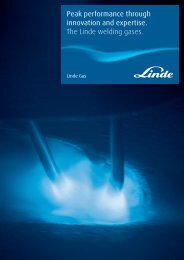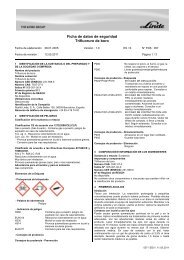REBOX oxyfuel solutions in reheating
REBOX oxyfuel solutions in reheating
REBOX oxyfuel solutions in reheating
Create successful ePaper yourself
Turn your PDF publications into a flip-book with our unique Google optimized e-Paper software.
Avesta <strong>oxyfuel</strong>(roller hearth).qxp:Avesta <strong>oxyfuel</strong>(roller hearth)_Reference 08-07-30 15.58 Sida 13 Reference sheet.<strong>REBOX</strong> ® <strong>oxyfuel</strong> <strong>solutions</strong> <strong>in</strong> reheat<strong>in</strong>g. Oxyfuelcombustion <strong>in</strong> a new roller hearth heat<strong>in</strong>g furnace.Roller hearth heat<strong>in</strong>g furnace with <strong>REBOX</strong> ® <strong>oxyfuel</strong> solution <strong>in</strong>clud<strong>in</strong>g ceramic <strong>oxyfuel</strong> burners and L<strong>in</strong>de control system.SummaryCustomer– Productivity max. 23.5 t/h– Fuel consumption 235 kWh/t– Discharge temperature 1140°C– Substantial reduction <strong>in</strong> NO X emissions– Overall flue gas volumes have been reduced by 75% when compared with a comparable furnacethat is heated us<strong>in</strong>g an air-fuel combustion systemOutokumpu, Hot Rolled Plate Division, Degerfors, Sweden.Outokumpu is a lead<strong>in</strong>g <strong>in</strong>ternational sta<strong>in</strong>less steel producer with production plants <strong>in</strong> F<strong>in</strong>land, Sweden, the UKand the US. At the Degerfors plant <strong>in</strong> Sweden, Outokumpu produces sta<strong>in</strong>less slabs, blooms, billets, bar and plate.Customer objectivesBackgroundFor this project Outokumpu had the follow<strong>in</strong>g objectives:– Increased productivity as a result of mov<strong>in</strong>g from a batch to a cont<strong>in</strong>uous process– Increase capacity– Reduced operat<strong>in</strong>g costs– Ma<strong>in</strong>ta<strong>in</strong> or reduce emissions emanat<strong>in</strong>g from the heat treatment process– Improve product quality (particularly on the Duplex grades)– Reduce surface mark<strong>in</strong>gs/imperfections on the heat-treated plate.L<strong>in</strong>de was <strong>in</strong>vited to work with Outokumpu and the furnace designers to provide an <strong>oxyfuel</strong> combustion systemthat would help Outokumpu achieve their stated objectives.In 1998, the result of the co-operation was a new furnace, 35.4 m long (<strong>in</strong>side chamber), 3.5 m wide and 2 mhigh that is equipped with an <strong>oxyfuel</strong> combustion system that uses 59 of the latest L<strong>in</strong>de designed ultra-low NO Xstaged ceramic burners controlled <strong>in</strong>dependently <strong>in</strong> each of the 13 zones. As the name <strong>in</strong>dicates, these burnersare designed to m<strong>in</strong>imise the formation of NO X . However, the design offers several other benefits. They are easyto handle and ma<strong>in</strong>ta<strong>in</strong>, and as they are self cool<strong>in</strong>g they require no cool<strong>in</strong>g water which can be a commonsource of problems with many burners. Each burner is equipped with a flame-watch detection system and a pilotburner for auto ignition.The total power <strong>in</strong>put capability is 16.5 MW which allows hot or cold material to be charged and heated to a maximumtemperature of 1150°C before quench<strong>in</strong>g. The burner power <strong>in</strong> each zone can be controlled <strong>in</strong>dependently® <strong>REBOX</strong> is a registered trademark of The L<strong>in</strong>de Group.
Avesta <strong>oxyfuel</strong>(roller hearth).qxp:Avesta <strong>oxyfuel</strong>(roller hearth)_Reference 08-07-30 15.58 Sida 23 <strong>REBOX</strong> ® <strong>oxyfuel</strong> <strong>solutions</strong> <strong>in</strong> reheat<strong>in</strong>g. Oxyfuel combustion <strong>in</strong> a new roller hearth heat<strong>in</strong>g furnace.2 of 2via set temperature loops that follow temperature measurements from three thermocouples <strong>in</strong> each zone. Goodflow control accuracy is very important and this is achieved by us<strong>in</strong>g a differential pressure V-cone orifice which isthen recalculated to a temperature and pressure compensated mass flow. This, coupled with state of the art Bil<strong>in</strong>earGeneralized Predictive Controllers (BGPC) that work with conventional PID’s, take account of non-l<strong>in</strong>earcharacteristics and m<strong>in</strong>imise deviations from the set-po<strong>in</strong>t. The result<strong>in</strong>g benefits are the ability to more accuratelycontrol the flows of oxygen and propane when chang<strong>in</strong>g power levels. As a result, this allows better controlof the result<strong>in</strong>g atmosphere and ultimately lower NO X values coupled with improved thermal efficiency.Installation/scopeResultsCustomer benefitsThe equipment <strong>in</strong>stalled was as follows:– 59 ceramic low NO X burners.– Separate flow tra<strong>in</strong>s for both oxygen and propane to the ma<strong>in</strong> burners and pilot burners <strong>in</strong>dividually to eachzone.– A complete control system allow<strong>in</strong>g <strong>in</strong>dividual control of each zone us<strong>in</strong>g PID <strong>in</strong> conjunction with bi-l<strong>in</strong>eargeneralized predictive controllers for optimum control for 12 of the 13 zones.The follow<strong>in</strong>g performance results have been achieved <strong>in</strong> this furnace:– Productivity max. 23.5 t/h– Fuel consumption 235 kWh/t– Discharge temperature 1140°C– Substantial reduction <strong>in</strong> NO X emissions.– Overall flue gas volumes have been reduced by 75% when compared with a comparable furnace that isheated us<strong>in</strong>g an air-fuel combustion system.Several key benefits have been achieved as a result of the use of <strong>oxyfuel</strong> combustion technology <strong>in</strong> this furnace:– High productivity furnace when compared with an air-fuel alternative due to faster heat<strong>in</strong>g capability.– Low specific fuel consumption.– More accurate temperature control of the plate material.– A cleaner environment with lower noise generation from the furnace operation.– Reduced overall flue gas volumes when compared with an alternative air-fuel fired furnace.– Substantial reductions <strong>in</strong> fuel borne emissions such as SO X , CO, NO X and CO 2 .Ultra low NO X ceramic burners.– A selection from the family ofL<strong>in</strong>de-designed <strong>oxyfuel</strong> burners.<strong>REBOX</strong> ® <strong>oxyfuel</strong> <strong>solutions</strong>In more than 110 fully converted reheat<strong>in</strong>g and anneal<strong>in</strong>g furnaces, L<strong>in</strong>de’s <strong>REBOX</strong> ® <strong>oxyfuel</strong> <strong>solutions</strong> providemore throughput and flexibility at lower total costs.– Up to 50% more furnace throughput capacity– Up to 50–60% specific fuel sav<strong>in</strong>gs– More uniform heat<strong>in</strong>g and reduced scale formation– Reduced emissions of such as CO 2 and NO XThe broad <strong>REBOX</strong> ® technology and application experience comb<strong>in</strong>ed with long and detailed customer processexperience results <strong>in</strong> fast and safe project implementation, also as turnkey and with guaranteed performance.L<strong>in</strong>de AGL<strong>in</strong>de Gases Division, Seitnerstrasse 70, D-82049 Pullach, GermanyPhone +49.89.74 46-0, Fax +49.89.74 46-12 30, www.l<strong>in</strong>de-gas.com/rebox43490352 0808 – 1.1 GDP Subject to change.




